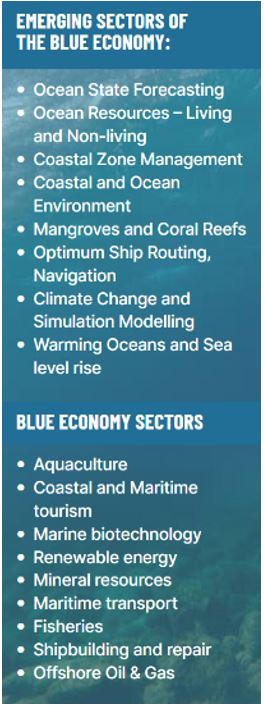

9th May 2024 (16 Topics)
Context
While maritime security and geopolitics (Indo-Pacific, rules-based international order) have dominated discussions in recent time, there's a need to prioritize economic development, particularly through harnessing the potential of the Blue Economy (BE).
Contribution of blue economy to economy
- India is the second-largest fish-producing country in the world, with a coastline spanning 7,517 kilometers across nine coastal states and 1,382 islands.
- Nearly 250 million Indians live within a distance of 50 km from the coastal areas of India.
- Its maritime industries include trade, shipbuilding, and cruise tourism, generate significant economic output.
- It provides employment opportunities for the approximately 4 million people.
- The 12 largest ports in India, along with 187 smaller ports, handle almost 1,400 million tons of cargo yearly; by volume, maritime routes account for 95% of all trade in the country.
- India’s fish production is only 6% of global production, and its contribution is only 1% to the national GDP.
- India’s blue economy supportsalmost 95 per cent of all businesses in the country through transportation, and it’s estimated worth is around 4 per cent of the country’s GDP.
- India's Exclusive Economic Zone of over 2 million square kilometres has a bounty of living and non-living resources with significant recoverable resources such as crude oil and natural gas.
- Blue Economy is intrinsically linked to the following SDGs:
- SDG 14- conserving and using oceans, seas, and marine resources for sustainable development
- SDG 13 - Climate Action
- SDG 6 - Clean Water
- SDG 7- Clean and Renewable Energy.
India’s measures to strengthen its blue economy
- The goal of the Global Maritime India Summit and the G20 are to foster a blue economy with an emphasis on green ports, sustainable infrastructure, cruise tourism, and international investments.
- Draft National Policy for Blue Economy was unveiled in 2021 with the goals of preserving marine biodiversity, enhancing the GDP contribution of the ocean economy, and improving the quality of life for coastal people.
- Deep Ocean Mission was established in 2021 to create technology such as underwater robotics and manned submersibles in order to extract both living and non-living resources from the deep ocean.
- Maritime India Vision, 2030 (MIV 2030) was unveiled with the goal of accelerating the maritime sector's ten-year growth while emphasizing the establishment of an environmentally sound and sustainable maritime sector.
- India launched its first Marine Spatial Planning frameworkin Puducherry in collaboration with Norway under the Indo-Norway Integrated Ocean Initiative to minimise conflicts between economic sectors.
- Sagarmala Project:The Sagarmala project is the strategic initiative for port-led development through the extensive use of IT enabled services for modernization of ports.
- O-SMART: India has an umbrella scheme by the name of O-SMART which aims at regulated use of oceans, marine resources for sustainable development.
- Integrated Coastal Zone Management: It focuses on conservation of coastal and marine resources, and improving livelihood opportunities for coastal communities etc.
- National Fisheries Policy: India has a National Fisheries policy for promoting 'Blue Growth Initiative' which focuses on sustainable utilization of fisheries wealth from marine and other aquatic resources.
Challenges faced by Blue economy
- Climate change, pollution, overfishing and inadequate regulatory frameworksare the major issues.
- Natural Disasters: Coastal communities in India face significant challenges from natural disasters exacerbated by climate change.
- Decline of oceans: Given the current state of decline of world oceans, the increase in development efforts could further deteriorate the situation.
- Erratic monsoons and warming tropical waters have already endangered these livelihoods.
- Marine debris (bottles, rubber, household items, and plastic bags), carries along with it a large number of invasive species to the Indian shores, thus becoming a new source of threat to the livelihood of the locals.
Fact Box:
Global Ocean Policy Initiatives:
|
More Articles



